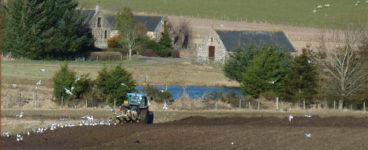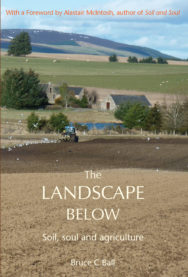“I’ve spent time in my career developing simple methods to observe soil and to learn from it. When I handle the soil, it says good things to me. It speaks of its willingness to suck up water, to take in fertiliser, to become warm and to feed me. But like everything it has its breaking point, although it also responds to kindness.”
Aimed at all concerned about the environment, this book presents a radical vision of the future of farming and community life, based on hidden insights from the life and spirit of the soil and on the author’s experiences of growing up in the small, agricultural community of Clatt in North-East Scotland. The author, Bruce Ball, a soils specialist has a research and consultancy career spanning more than 35 years. His regular contact with soil in the field and with farmers has led to a deep understanding of the critical importance of soil to our future survival.
Extract from The Landscape Below: Soil, soul and agriculture
By Bruce C Ball
Published by Wild Goose Publishing
INTRODUCTION
Man – despite his artistic pretensions, his sophistication and his many accomplishments – owes his existence to a 15cm layer of topsoil and the fact that it rains.
Anon.
I have appreciated the beauty of the natural world all my life. Growing up in a rural environment, the way I saw the world was shaped by the hills and rivers and the cycles of flowers, trees and animals. However, it wasn’t until middle age that I recognised the hidden beauty, in people, voices, eyes, gestures, poetry. That we often obscure beauty beneath ugliness and the materialism of the modern world is something I have come to see as a coping strategy for our loss of connection to the unseen value of all around us. The challenges society faces today suggest an addiction that has led to shortages of resources like oil, food and water and to reliance on things we have come to see as essential, while we ignore the ele- ments of life that have real value. The inequalities evident between rich and poor can load relationships with guilt and resentment, causing us to overlook the fact that we are all – in essence – the same.
I grew up with shortages because my folks didn’t have much money and we lived in a house without a reliable water supply. I came with economy built in. Our house was isolated but we had some land, a few hens, cows next door and plenty of wildlife, so what I lacked in toys and company I made up for by spending time outside learning the language of the hens, the animals, the birds, the trees, the vegetables, the stars and the soil.
Recently, I have begun to get impatient with our society which uses too much of everything, including other people, and which seems to be so angry and unhappy. Our destructive way of living, which burns up our last reserves of oil instead of conserving them for the next generation and which throws away so many things, is plain stupid. Sucking so much water out of the ground and fighting each other is plain stupid, as is our continued degradation of the environment.
I became a soil scientist mainly to learn how crops grew and to discover how to get them to grow better. We rely on the soil to feed us, despite our high-tech society, and we use crops and cultivation techniques that have changed little over the years. Only about 11% of the earth’s surface is covered by soil. Yet I soon realised that, even when we think we’re caring for it, we often treat that soil like dirt. We chuck fertiliser or water at it, churn it up and squash it back together with bigger and bigger machines. Our soils are losing their quality, becoming exhausted, so that over one third of the areas of productive soils are degraded. The soil is literally and figuratively the foundation of the environment, albeit hidden most of the time. Moreover, our soils are actually disappearing. As you read this, soils are being lost worldwide at an average rate of 300 tons per minute. If this continues, our remaining topsoil might not survive much beyond fifty years.
Shortages of soil, fertiliser and water will make it more and more difficult to feed our increasing population, leading to the very real prospect of food scarcity. Even if we’re not greatly concerned about global warming and peak oil, we can’t do without food. Nor can we deny that it is happening as some do with global warming. The evidence is clear in the lost soil, in problems with excessive nitrogen fertiliser use, in disappearing freshwater resources, destroyed forests, extinct animal species and desertification. There is no room for ‘abused land’ sceptics. We have already seen food riots and protests as a result of high prices. We need to learn the lesson from previous civilisations like that of the Maya. We tend to associate them with magnificent temples rising from the jungle. But they lost most of their soil due to erosion under their intensive agriculture. Those who destroy their soils ultimately destroy themselves.
I’ve spent time in my career developing simple methods to observe soil and to learn from it. When I handle the soil, it says good things to me. It speaks of its willingness to suck up water, to take in fertiliser, to become warm and to feed me. But like everything it has its breaking point, although it also responds to kindness. There is a parallel between caring for the soil and caring for others. I believe that achievement of this caring involves a search for beauty, not as an abstract concept but as a recognition of value.
My search began back in the community where I grew up. The people there loved the soil and conserved the environment instinctively. Most had successfully assimilated modern ways, yet had kept a traditional approach in their relationship with the land and with each other.
As a child, I recognised beauty in the yellow and brown colours of the local soil. As an adult, I discovered the strange purple soils derived from lava-like pumice stone in the nearby village of Gartly. The differences in colour alone remind us of the hidden complexity in the earth we walk on. Soil was described by Hildegard of Bingen four hundred years ago as ‘afire with the light of God’. This light comes from below as a crop germinates and emerges – she calls it ‘the greening power of the soil’. But the action of this light for growth depends upon the health of the soil and, because of its hidden nature, when its quality diminishes, we may not notice until it is too late.
In a similar way, our mental and spiritual health is being eroded from the foundations of our communities and our wider society. Globally we are facing an economic recession. In the northern hemi- sphere we are also facing a social recession. Despite the accumulation of material wealth, which we believed would bring us security, there is growing violence, pressure on the environment and widespread social inequality which makes us feel increasingly unhappy and isolated.
My career as a soil scientist began as a search for ways to improve yields for economic growth. My work with church groups began as a means of re-creating community. Both have brought unexpected results. Through recognising the beauty of the soil and the bonds between people, I have a greater appreciation of both and have found that the original aims of economy and community can be achieved in more holistic ways, by reconnection with the land and tuning in to the urge of the spiritual. We need to get back to our roots in the soil and delve within us to access the stored knowledge of past generations. There are close links between how the soil works, and how we manage it, and how we cope with others and manage our lives. This was well illustrated in the community of Clatt where I grew up. The people of the soil – those who not only work the land but also feel for it – were those who fostered com- munity developments. There was a tangible link between caring for the soil and caring for people.
Good soil management is not easy and our quick-fix approaches often lead to long-term damage. We could possibly feed ourselves without environmental damage if we all behaved rationally. But we have never behaved rationally before, so it’s unlikely that we will now. We claim to be ecological in fighting pollution and resource depletion. Yet this is often with the objective of preserving the health and affluence of people in developed countries – ‘shallow ecology’ in other words. In contrast, deep ecology1 sees the world as a net- work of phenomena that are all fundamentally linked and interdependent. This approach values all people, animals, plants and minerals equally. To move towards this deep ecological approach I think we need some help from the spiritual. We need to become aware of the sacredness of our environment, to listen and learn and become conscious of our connection to the spiritual within all things, so that we treat everything with reverence. In this book I look to the inner space both of soil and of humanity. I show the urgent importance of soil life for the future of humankind. The management of soils and farming can integrate with the spiritual and the social to point us towards the creation of sustainable communities based on beauty, justice and transformation. In this way we will be able to satisfy our needs and desires without robbing future generations.
To maintain my connection with the real world, I wrote this book on trains, boats, planes and, with some difficulty, on buses. This brought me into some interesting conversations with comments like:
‘You might change soil but you won’t change people.’
‘Ah you’re one of those who think all men are your brothers, then?’
‘You need to stop those immigrants from ripping us off and taking our jobs.’
‘Do you really believe in global warming?’
‘Why should we work when others can’t be bothered to get out and find a job?’
‘The economy has to grow for us to survive.’
‘We have always managed to adapt to problems in the past.’ ‘OK, so what are you, personally, doing about it?’
The result is a book about the hidden life of the soil and about the hidden forces that drive you and me. Developing an awareness of hidden problems and opportunities, and acting on them by searching for beauty, offers some pointers for improving our lives. Beauty ultimately comes from our inner landscape and often appears when we are waiting on the spiritual. The searching itself brings awareness of our every action, our environment and our resources and has a natural outcome in a desire for the good of others.
Note:
1 The concept of deep ecology was attributed originally to Naess 1973 and an example of its development is given in Capra 1997.
The Landscape Below: Soil, soul and agriculture by Bruce C Ball with a foreword by Alastair McIntosh, is now published by Wild Goose Publications priced £9.99.
ALSO IN THIS ISSUE

 The Blood
The Blood
David Robinson reviews The Blood by ES Thomson – the latest Jem Flockhart crime novel – and asks: wh …

 The Landscape Below
The Landscape Below
“I’ve spent time in my career developing simple methods to observe soil and to learn from it. When I …













